Do you remember the fascinating chapter on medieval history from your school times? The one about the Delhi Sultanate and the rise and fall of its dynasties?
Delhi, famously known as ‘Dil Walon ki Dilli’ is the capital city of India. While Kashmir is looked upon as the Crown and Kanyakumari is the Foot, Delhi is the Dil, i.e., the Heart of the country.
With its bustling hot streets and mouthwatering delicacies, Delhi is also famous among the tourists for its history and monuments. From Muhammad Ghori to the British Raj, Delhi has always been a prime location in the history for the invaders to establish their own sovereignty. And when they left, they left behind their flavorsome cuisine and admirable architectures.
While it is difficult to list down all these monuments in a single category (as they all differ from era to era and in purpose), through this blog we will try to cover the monuments specifically built in Delhi during the Delhi Sultanate and its dynasties.
MAMLUK OR SLAVE DYNASTY
THE QUTB MINAR COMPLEX
Muhammad Ghori (Ghurid Dynasty) ruled Delhi by defeating the Rajput ruler Prithviraj Chauhan in the second battle of Tarain in 1192 and thereafter established a Muslim rule in Delhi. However, he did not contribute much to the architectures of Delhi. His assassination led to Qutub-ud-Din Aibak (Mamluk Dynasty) establish the Delhi Sultanate in 1206, as he (Qutub-ud-din Aibak) crowned himself as the Sultan of Delhi.
- The construction of QUTB MINAR (World Heritage Monument), the victory tower in the Qutb complex, was started by Qutub-ud-din Aibak, on the victory of built the ruins of the Lal Kot. The Qutb Minar is 72.5 meters in height, and therefore is the tallest bricks-built minaret in the world. Aibak only built it up to the first storey, while the other three storeys were built by his successor, Iltutmish and later got a touchup from Firoz Shah Tughlaq (Tughlaq Dynasty) as well, showcasing the structural variation.
Built in different eras under different rulers, this rare beauty of sandstone and marble will leave you awestruck.
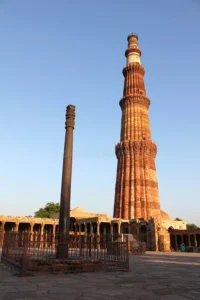
- QUWWAT-UL-ISLAM MOSQUE was built alongside the Minaret, using the remains of twenty-seven Hindu temples (destroyed by these invaders) built during the reigns of the Tomars and the Chauhans, while leaving a certain part of the temple outside in the premises. It is the first Mosque that was built in Delhi after the Islamic conquest of India.
After the death of Qutub-ud-din Aibak, Iltutmish became the new sultan of the Mamluk dynasty. The construction of the minaret was then resumed under his reign, him building the next three storeys.
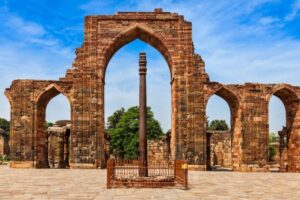
The complex also consists of an Iron Pillar and other constructions such as the Tomb of Iltutmish, Alauddin Khalji’s Tomb and the Alai Darwaza (will be discussed later). The Qutb complex is fun to walk in especially if you are a history lover and a master at connecting dots. You can visit it yourself or you can even sign up for the various heritage walks that are recently being organized in Delhi to have a better look!
KHALJI DYNASTY
The Khilji Dynasty is known for its architectural innovations, including the use of arches, domes, and minarets. Their monuments showcase a blend of Indian, Persian, and Islamic architectural styles. While there were new architectures being built the older ones were being extended aswell.
- HAUZ KHAS a place very well known among the tourists and the locals for its night life. From cafes to bars to thrift stores and art galleries, the Hauz Khas village is one of the most thriving places in Delhi. But the complex is not limited its boozy cafes and trendy clothes. The Hauz Khas Fort was built in the 14th Century by Alauddin Khalji, the second ruler of Khalji Dynasty. Initially built as a Madarsa and Mosque, it was later extended under the rule of Firoze Shah Tughlaq. The complex of the fort is a perfect area to spend your evening walking with your friends, with the Hauz (lake) by your side. The lush green areas and the sound of the nature contrasts with the trendy vibrant cafes. Just perfect!
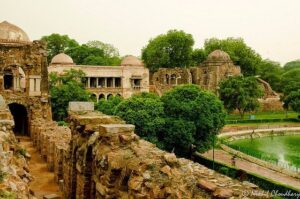
- ALAI DARWAZA was built in the Qutb complex by Alauddin Khalji in the 1311 AD. It is also the first ever dome to be built in India. As the name suggests it is a gateway (Darwaza) from southern side of the Qutub and is adorned with beautiful red stone and white marbles which showcases the fineness of the Turkish craftsmanship. The Khalji dynasty came up with original ideas and architectures built up from scratch. If you are visiting Qutb Minar, make sure to see this wonder of the Islamic architecture.
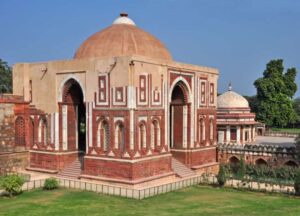
TUGHLAQ DYNASTY
- TUGHLAQABAD FORT is a medieval fort in Delhi, built by Ghiyas-ud-din Tughlaq, the founder of the Tughlaq Dynasty, in the 14th century. Now in ruins, the fort’s strategic location and heavy built have had served its purpose of both defense and aesthetics. The surrounding consists of lushy greens which contrasts with the grand architecture, providing the visitors with a rather peaceful atmosphere. Although the fort is depleting gradually, the view is still worth to stand for a moment and watch. The beautiful Aravalli and the aura of the fort will take you back in times to the stories of bravery and wars, of revolt and betrayal.
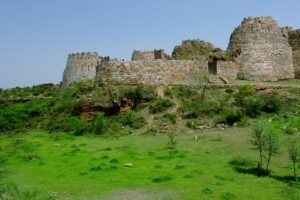
- The FEROZ SHAH KOTLA was built in the 14th century under the reign of Feroz Shah Tughlaq, the ruler of Tughlaq dynasty. The heavy walls of the forts made up of red sandstone and limestone are now in ruins with two grand gates namely the Delhi Gate and the Talaqi Gate. The fort still resonates of the history and its local legends, including stories about the Tughlaq dynasty. The premises has also served as an auditorium to many of the musical nights in Delhi in the pre-independence era. The Jami Masjid built in the premises of the Kotla is one of the most ancient and largest surviving mosques, still in use. The Kotla is also adorned with a Baoli and an Ashoka pillar.
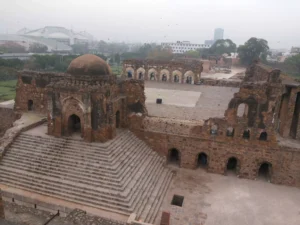
- Located in the Khirki village of Delhi, is the KHIRKI MOSQUE. The word Khirki in urdu means windows and therefore the name Khirki Mosque. One of the mosque’s most striking features of the Mosque is its lattice work on the windows on the second floor. The net like carvings on the marbled walls act like windows allowing the smooth passage of air and light. Built under the reign of Feroz Shah Tughlaq, this mosque is yet again a fine example of the beauty of Tughlaq architecture. The mosque is an example of early Indo-Islamic architecture and reflects the transition from earlier Islamic architectural styles to those that emerged in the Mughal period.
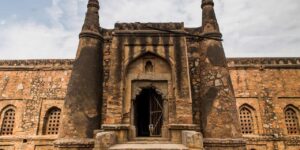
SAYYID DYNASTY
The architecture of this dynasty is limited to tombs built for its rulers scattered throughout Old Delhi. Although Lodhi Gardens is well known for its association with the Lodhi Dynasty, its dawn was sown way before in the Sayyid Dynasty with construction of the tomb of Mohammed Shah, the last of the Sayyid dynasty rulers (the earliest of the tombs in the garden) in 1444 by Ala-ud-din Alam Shah as a tribute to Mohammed Shah. Several other lesser-known Sayyid tombs are scattered throughout the Lodi Gardens complex.
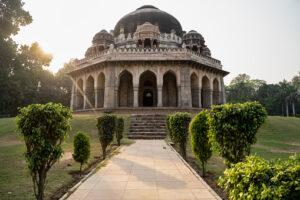
LODHI DYNASTY AND THE DECLINE OF DELHI SULTANATE
- LODHI GARDENS, stands as a fine example of the architectural style of the Lodhi Dynasty. Spread across 90 acres, this place is an absolute gem with lush greenery, well maintained lawns, flower gardens and a pond. Yes, a pond! And you can spot swans in there too! This architecture marvel is yet another fine example of tomb with manicured gardens, water bodies and fountains. Throughout the year the gardens are adorned with seasonal flowers giving it a picturesque view while serving as home to small animals and birds. The tomb of Sikander Lodhi lies among the other Tombs on the site and it is the perfect spot for the visitors to sit and relax under the clear sky.
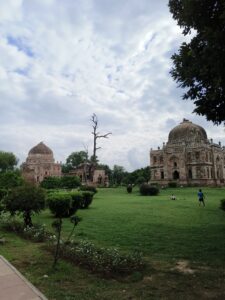
- JAHAZ MAHAL is one of the venues of the annual festival of the Phool Walon ki Sair, which signifies the brotherhood between the Hindus and Muslims. A procession (conducted right after the monsoon season) of pankhas (fans) made up of flowers carried by the flower vendors starts from the Hauz-i-Shamsi tank called “Jharna”, stops at the Yogmaya Temple for the first offering of the flower fan as mark of reverence, moves to the Jahaz Mahal and finally ends at the famous Dargah of Hazrat Qutbuddin Bakhtiar Kaki for offering of the fans and chadar at the Dargah. If you are someone who appreciates different cultures witnessing this three-day celebration should be on your to-do list!
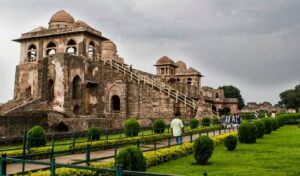
THE MUGHAL DYNASTY
After the decline of the Delhi sultanate, the Mughal Dynasty came into power. Though not a part of the Delhi Sultanate, the Mughals have played a huge role in the history of Delhi and its fascinating monuments.
- You might have heard of ‘Taj Mahal’ one out of the seven wonders of the world, but have you heard of the red-stone Taj Mahal? Well, we are here to tell you about it. Built in 1558 by the widowed wife of Mughal Emperor Humayun, Bega Begum, the HUMAYUN’S TOMB is famously known for its undeniable architectural beauty. Built by finely selected Persian architects, this is the first ever garden tomb built in India. The beauty of this UNESCO World Heritage is not only limited to the building and its dome, but also the Charbagh, the four-fold Persian inspired garden (spread across in 30 acres) which provides a serene atmosphere to the visitors. Its red sandstone and white marble façade, combined with intricate marble inlays and carvings, create a striking visual appeal. Do not forget to check out the other small monuments and the newest addition, the Humayun Museum in the premises on your visit. An absolute beauty!
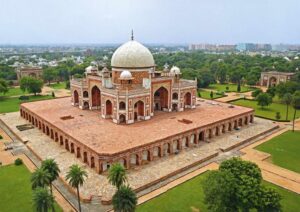
- LAL QILA or the Red Fort is yet again a wonder of the Islamic architecture. The Red Fort is renowned for its striking red sandstone walls, which give it its name. In an area of 254.67 acres the marble, floral decorations and the fort’s double domes exemplify later Mughal architecture. The Diwan-i-Aam, Diwan-i-Khas, Mumtaz Mahal, Khas Mahal, the Hammam, and Rang Mahal were built under Shah Jhan’s supervision.
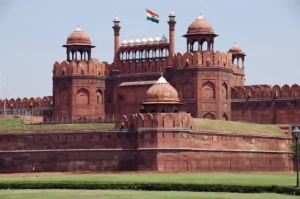
Moti Masjid, a later addition was made by Aurangzeb, the next Mughal emperor. to know more about this masjid visit: Moti Masjid – White Marble Mosque Inside Red Fort Complex (delhiunlimited.com)
The Lal Qila is now a monument of great importance for the government of India, as every year on 15th August (Independence Day) the Prime Minister of India hoists the national flag at the fort’s main gate and delivers a speech.
- Located in the heart of old Delhi is JAMA MASJID. Built between 1650-1656 by the Mughal Emperor Shah Jahan, the beauty of this Mosque is undeniable. The design of the Mosque is a mixture of Persian, Indian and Islamic style, made up of red sandstone and white marble intricates. The interior is adorned with beautiful calligraphy and detailed floral carvings. In the present scenario, Jama Masjid is not only a place for offering prayers, but it is a monument of great historical importance with bustling streets and famous markets surrounding it. If you are in Delhi, make sure to pay your visits to this marvelous place and do not forget to go to Chandini Chowk later!
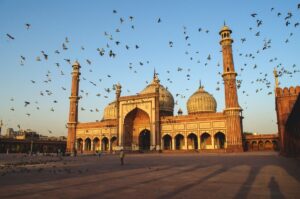
CONCLUSION
Delhi, the capital city of India is a treasure of historical monuments which reflects the rich history of this place. Every monument here speaks of the era it was built in, and the architectural style of the time. While Aibak used the remnants of the temples, Iltutmish constructed it from scratch. From Ghurid to Mughal Dynasties, a timeline where you can actually notice the evolvement of the architectural styles (including mixing of styles/ hybrids).
Let me know in the comment section which state/city/place’s history you would like to know about I will see you in the next blog.
Check out our blog to know /11-historical-temples-of-south-india/

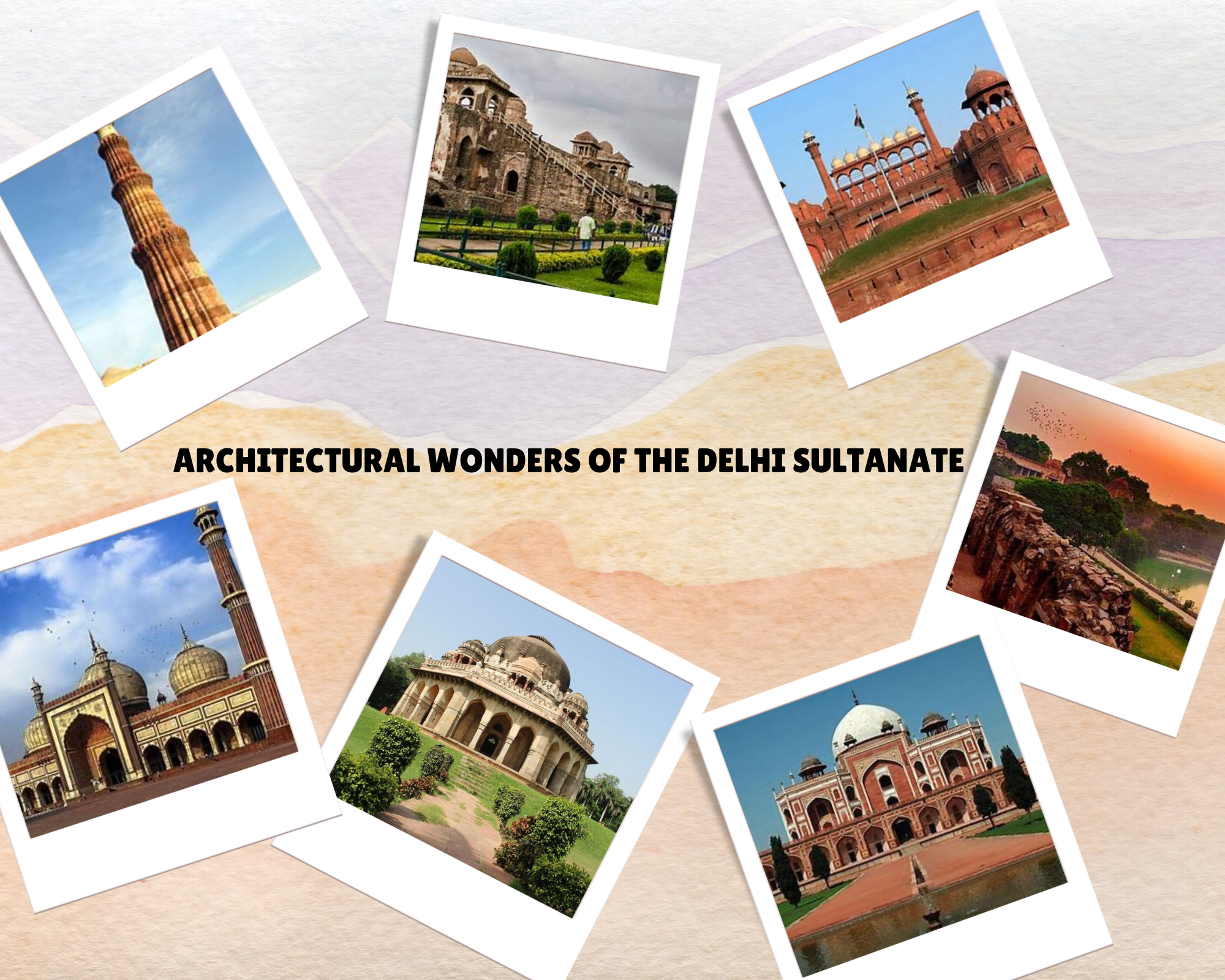
Zahar content… waiting for more!
You’re so dedicated when it comes to create such good content. Moreover, this is such a great idea to educate your targeted audience to history they’re forgeting about. Keep it up. You’ll make it bigger soon.